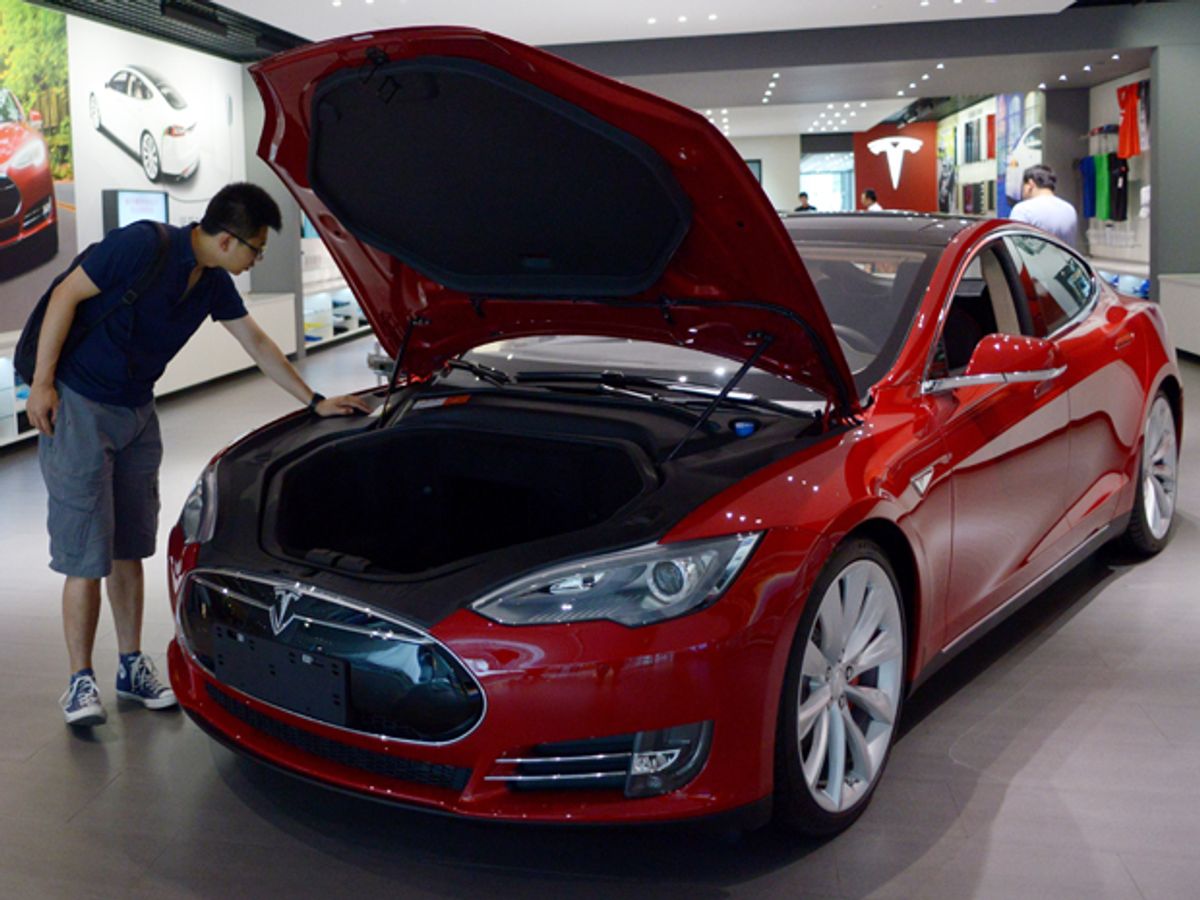Tesla Motors, which this summer announced a partnership with Panasonic to build a battery “Gigafactory,” may be overreaching. A new industry analyst’s report questions whether the demand for the company's electric cars will be big enough within the next five to eight years to warrant the factory’s projected $5 billion investment.
According to the new report, by 2020 Tesla could be facing substantial overcapacity, with too many batteries and not enough EV cars — and other applications like renewable grid energy storage — to put them in.
Specifically, the report by Boston-based firm Lux Research projects that Tesla and Panasonic’s gigafactory, now reportedly to be sited in either California or Nevada, will only reduce the price of the next Tesla car, the Model 3, by $2800. (Update: It looks like, if current reporting and Nevada Senator Harry Reid's recent comments are correct, Nevada will be the new factory's home state.) “The Tesla Model 3 will be a success or failure largely irrespective of the Gigafactory,” the report says. “Consumers will make their decision about the appeal and value proposition of a 48 kWh Tesla EV based on other factors, not a $35,000 versus a $37,800 price point.”
And according to Lux’s analysis, by 2020 consumer demand for Teslas could run from 240,000 EVs (which they deem a “likely case”) up to 510,000 EVs (which they call the “optimistic” case). So when Tesla says it aims to sell a half-million cars in 2020, says Lux report co-author Kevin See, it’s relying on high-end numbers. People who accept Tesla’s sales projection, he says, should know it’s a rosy forecast.
Even at 240,000 cars sold, compared to tens of thousands today, it'd represent a massive growth for Tesla. But, the report notes, the financial viability of such less-than-projected performance would still depend on how wisely and carefully Tesla spends on other things like charging infrastructure and its relationship to its growing consumer base.
It's a different story for battery makers, though. If Lux’s likely scenario comes to pass, then the Gigafactory will by 2020 be turning out
just one-third
less than half of its projected capacity (i.e. of the factory’s 35 gigawatt-hour capacity, 20 GW would be overcapacity). And See says Tesla and Panasonic could be hard-pressed to fill the overcapacity gap with orders from other EV carmakers — especially since Tesla’s unique battery design, consisting of thousands of small cells strung together, would render the factory’s output incompatible with cars like the Nissan Leaf and Chevrolet Volt.
Plus, he says, stationary applications like Tesla’s partnership with San Mateo, Calif.-based SolarCity aren't projected to generate enough kilowatt hours to fill the factory’s projected overcapacity.
“It’s an easy talk track to say, ‘We’ll just sell our batteries into other stuff,’” See says. “But you have to look at those other markets and applications to determine whether that’s real or not. Are renewables going to come on line more? Yes. Is there going to be more solar? Yes. But that does not mean you’re going to have this endless demand for battery packs.”
So if Lux analysis is right, then why is Tesla pushing so hard for the Gigafactory in the first place? Is the company just too bolstered by its own optimism?
Here, See argues, is where Tesla may perhaps be even savvier than fans who might not question the half-million-by-2020 sales figure and thus not expect overcapacity.
As a carmaker, Tesla’s biggest variable is batteries. But making cells overseas and then shipping them around the world subjects the company’s entire business model to setbacks like tariffs, shipping delays, natural disasters and fluctuating currency exchange rates. But in having Panasonic help subsidize the Gigafactory in the US, the Lux report says, Tesla “has pulled off an impressive coup by convincing Panasonic and other partners to subsidize its own logistics to the tune of billions of dollars.”
“What gets lost is Tesla has pushed its risk onto the rest of the supply chain, which is smart,” says See. “But the rest of the supply chain has a big concern. Because if they’re going to put this money in, they need to see that in these different scenarios they can come out profitable. But that is not certain.”
Nevertheless, the report does call into question Tesla's rosy forecasts — which stands to diminish Tesla’s Apple-like aura. And for this See says he knows he and his co-authors may take some knocks.
“I’ve read the comments on the [Tesla] stories. I know what’s coming,” he says. “But this is our job. We are experts in this space. We talk to the leading manufacturers, we talk to the end users. We talk to the people taking the lithium out of the ground, to the guys making the cathodes and anodes. Our objective is to follow these spaces, to understand the trends, to understand the technical obstacles and how that translates to market opportunity.”
Margo Anderson is the news manager at IEEE Spectrum. She has a bachelor’s degree in physics and a master’s degree in astrophysics.



